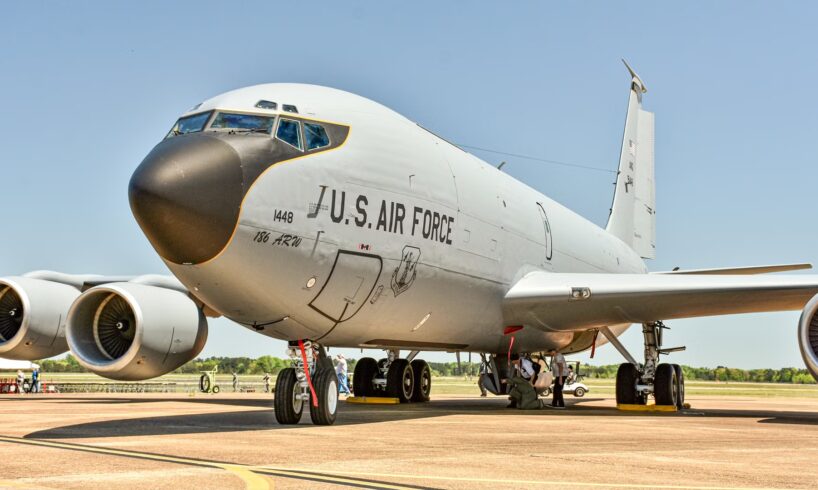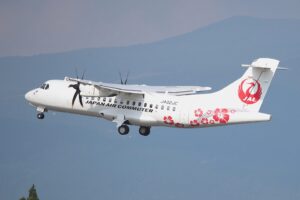
The Boeing KC-135 Stratotanker remains one of the longest-serving military aircraft in history, a true workhorse that has supported USA operations around the globe for nearly seven decades. Since its maiden flight in 1956, the aircraft has transformed from a straightforward fuel carrier into a versatile platform capable of aerial refueling, personnel and cargo transport, reconnaissance missions, and even medical evacuation.
Over the years, continuous upgrades, from engine re-engineering and avionics modernization to structural enhancements, have kept the fleet relevant in an era of rapidly evolving technology. Even as newer-generation tankers, such as the KC-46 Pegasus, gradually enter service, hundreds of KC-135s remain in operation, forming the backbone of America’s global aerial refueling capability. This article will take a detailed look at how many KC-135s are still active, the different variants that continue to fly, and what the future holds for this iconic fleet as it nears its 70th anniversary of service.
How Many KC-135s Are Still Flying?
Credit: US Air Force
In 2025, the KC‑135 fleet is still surprisingly large and active. The United States Air Force has roughly 396 Stratotankers in total: about 153 in active‑duty wings, 171 assigned to Air National Guard units, and some 72 with the Air Force Reserve. That’s a remarkable survival story for an airframe whose roots reach back to the 1950s, meaning that nearly seven out of ten KC‑135s are still flying in some capacity.
Despite its age, the KC-135 fleet remains mission-ready thanks to continuous modernization programs: the Stratotanker fleet stays mission ready because the USAF has continuously refreshed avionics, communication suites, and structural components, while rolling out life extension and modernization programs. Those upgrades keep the airframes compatible with modern receivers and allow frequent deployments: many KC 135s fly multiple sorties each week, supporting everything from routine NATO training to long-range tanker tasks across Europe, the Indo-Pacific, and the Middle East.
The Air Force is steadily introducing the KC 46 Pegasus and laying groundwork for future KC X recapitalization, yet the transition isn’t instantaneous. The KC 135 will remain a workhorse well into the 2030s as the service balances replacement timelines, budget realities, and the need to sustain global tanker capacity. So when you see a KC 135 overhead, you’re looking at a classic that’s been kept relevant: an old design made modern by upgrades, careful logistics, and the sheer utility of being a reliable flying gas station for the world’s air forces.
What Keeps The KC-135 Relevant After Nearly 70 Years?
Credit: USAF
The KC-135’s staying power comes down to one word: upgrades. Over the decades, the fleet has seen structural reinforcements, avionics refreshes, and a game-changing re-engining program in the 1980s and 1990s. These improvements, combined with a steady rollout of digital and mission systems updates, have allowed the Stratotanker to remain operationally relevant in today’s highly networked battlespace. Many airframes now feature modern cockpit displays, tactical data links, and satellite communications suites, integrating a 1950s-era design into contemporary operations.
Originally fitted with Pratt & Whitney J57 turbojets, most KC 135s were later re-engined with CFM International CFM56 turbofans (the KC 135R/T configuration). The switch delivered major practical benefits: notably better fuel efficiency, a large increase in offload capability, and a far quieter aircraft on departure and arrival. It’s the reason a type designed in the 1950s can still meet modern operational demands and interoperability requirements.
Upgrades have gone far beyond engines. The KC-135 fleet has benefited from avionics and mission systems modernization (digital flight decks, improved autopilots, and modern comms), structural life extension work, and new maintenance and health monitoring tools that keep flying hours affordable and predictable.
Modern KC-135s feature digital flight decks, enhanced autopilot systems, and satellite communication suites that meet today’s international air traffic management standards. A subset of airframes of KC 135s has been refitted with multipoint refueling pods acquiring hose and drogue capabilities, allowing them to refuel two aircraft simultaneously, an important characteristic for coalition operations and air forces interoperability.
Variant
Engine
Thrust (per engine)
Max Fuel Offload
Efficiency Gain
NoNtes
KC-135A
Pratt & Whitney J57
13,750 lbf
150,000 lbs
Baseline
Original version (1957–1990s)
KC-135E
Pratt & Whitney TF-33-PW-102
16,050 lbf
175,000 lbs
+10%
Retired 2009
KC-135R/T
CFM International CFM56
21,634 lbf
200,000 lbs
+25%
Current active models
Put together, these improvements keep the KC 135 relevant: a reliable and robust platform that can be upgraded incrementally, rapidly task organized for global missions, and sustained by existing logistics and training pipelines. The USAF will continue to operate KC 135s into the 2030s while newer tankers like the KC 46 and future KC X come on line; for now, capability and cost-effectiveness keep the Stratotanker in the sky.
What Do These Numbers Mean For US Air Power?
Credit: USAF, National Archives Catalog
The KC 135 remains crucial for US air power because aerial refuelling directly multiplies the reach and endurance of combat and support aircraft. Tankers enable fighters to hold on station, allow bombers to strike from stand-off bases, and keep transports on long logistics routes, tasks the KC 135 still performs daily in exercises and real operations. Recent deployments show Stratotankers supporting NATO posture flights in Europe, sustained presence missions in the Indo-Pacific, and coalition operations in the Middle East.
Operational distribution matters too. Active Air Mobility Command wings take the global lead, while the Air National Guard and Air Force Reserve provide regional surge capacity and sustainment. That mix gives the USAF flexibility: active units carry the heaviest wartime tasking, Guard units hold the regional presence and domestic response roles, and Reserve units add depth for extended campaigns.
Command
Estimated Aircraft
Notes
Air Mobility Command (Active Duty)
153
Main operator, global tasking
Air National Guard
171
Regional and overseas missions
Air Force Reserve Command
72
Training and strategic support
Total
396
As of 2024–2025 data
The KC 135’s continued relevance is a capacity decision. New tankers arrive slowly, budgets constrain recapitalization, and demand for refueling only grows as the US projects power farther from home. Analysts and doctrine writers argue the service must prioritize tanker capacity for great power competition, not just replacement technology, because shortfalls in tankers would force mission compromises across the force.
Modernization and experimentation keep the type useful even as replacements enter service. The Air Force is exploring advanced concepts, from autonomy trials to improved sustainment tools, that could squeeze more capability from the existing fleet while new tankers are fielded.
How Does The KC-135 Compare To Other Tankers?
Credit: US Air Force
The KC-135’s replacement, the KC-46A Pegasus, is a more modern aircraft derived from the Boeing 767 platform. It brings advanced refueling systems, defensive suites, and a digital cockpit. But many Pegasus tankers are still entering service, and the Air Force continues to rely on the KC-135 fleet to meet operational demand.
Below is a comparison of key tankers in service or recently introduced, showing their platforms, maximum fuel capacity, and typical takeoff weights:
Aircraft
Approx. Maximum Fuel Capacity
Typical Maximum Takeoff Weight (MTOW)
Boeing KC-135R/T Stratotanker
~200,000 lb (90,700 kg)
~322,500 lb (146,300 kg)
McDonnell DouglasKC-10A Extender
~356,000 lb (161,500 kg)
~590,000 lb (267,600 kg)
Boeing KC-46A Pegasus
~212,000 lb (96,200 kg)
~415,000 lb (188,200 kg)
Airbus A330 MRTT
~245,000 lb (111,100 kg)
~560,000 lb (254,000 kg)
Ilyushin Il-78 Midas
~180,000–220,000 lb (81,600–99,800 kg)
~353,000–440,000 lb (160,100–199,600 kg)
Embraer KC-390 (Tanker Conversion)
~40,000–60,000 lb (18,100–27,200 kg)
~260,000 lb (117,900 kg)
Lockheed Martin KC-130J
~61,000 lb (27,700 kg)
~164,000 lb (74,400 kg)
The KC-135 remains highly valued despite its age. Its smaller size allows for easier deployment to remote or austere locations, while maintenance is simpler compared to the KC-10 or KC-46. Operational costs are also significantly lower, which is why the USAF continues to rely heavily on the KC-135 for both strategic and tactical refueling missions.
The larger KC-10 Extender, which was retired from the USAF last year, excelled at very high-volume fuel offload but came with a heavier footprint and higher operating costs. This was one of the reasons why it was phased out before the older KC-135. At the same time, the KC-46A brings modern avionics and mixed boom/drogue capability but is still being phased in.
Additionally, International platforms like the Airbus A330 MRTT provide flexibility with passenger and cargo configurations, while tactical options such as the Embraer KC-390 Millennium and Lockheed KC-130J Hercules are optimized for regional and expeditionary missions.
Are There Risks Or Drawbacks To Keeping The KC-135 Flying?
Credit: USAF
Age is undoubtedly the KC-135’s biggest adversary. The youngest Stratotanker in service was built in 1965, meaning even the most “modernized” airframes are now approaching 60 years old. With decades of continuous operation, corrosion, wiring degradation, and metal fatigue are constant concerns, requiring meticulous inspection and preventative maintenance.
Each aircraft undergoes extensive depot-level maintenance approximately every five years, a process in which technicians strip, inspect, and rebuild major structures. While this ensures safety, it also comes with significant costs and lengthy downtime.
The Air Force faces growing logistical and operational challenges as well, including:
Sourcing obsolete or discontinued parts, which can slow repairs and require custom fabrication.
Managing metal fatigue and structural wear, necessitating careful inspection of critical components.
Updating training and procedures for maintenance crews who were never originally trained on the 1950s-era design.
Higher operational costs, as older airframes consume more maintenance hours and support resources.
Despite these hurdles, the fleet maintains impressive readiness rates, thanks to decades of engineering upgrades, life-cycle management programs, and highly specialized depot teams. Yet, as the aircraft continues to age, these maintenance demands will only grow, emphasizing the strategic importance of introducing replacements like the KC-46A Pegasus while still relying on the KC-135’s proven deployability.
What’s The Future Of The KC-135 And Aerial Refueling?
Credit: US Air Force
The US Air Force plans to gradually retire the KC-135 fleet as the KC-46A Pegasus becomes fully operational and the next-generation KC-X program takes shape. However, with nearly 400 Stratotankers still airworthy, complete replacement could take another decade or more.
Some KC-135Rs may receive further digital upgrades to bridge the gap, ensuring operational readiness into the early 2030s. Boeing and the Air Force also continue to explore autonomous refueling systems and potential drone tanker concepts for future operations.
The KC-135’s enduring legacy lies in its adaptability, a 1950s design that remains at the heart of 21st-century air mobility. As newer platforms take over, the Stratotanker’s influence will live on in every tanker that follows.






